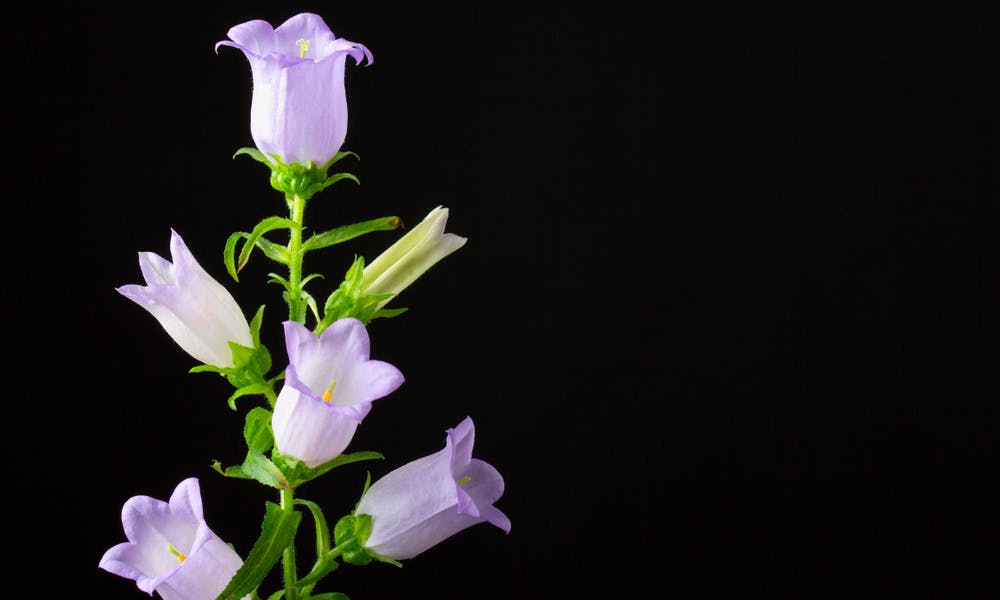The bellflower is a lovely flower in the shape of a bell or star. Its abundant and long-lasting flowering makes your small gardens, balconies, and terraces look beautiful and charming. In addition to that, the bell flower is easy to grow.
The bellflower, formerly known as Campanulaceae, contains more than 90 genera and more than 2,300 species of herbaceous plants. The bellflowers with blue colors are widely used as garden ornamentals. You can often find them in tropical regions as they adapt to temperate weather. There are many shrubs and herbs of the bellflower.
In this article, we are going to learn more about the beauty of bellflower including the following information:
- About bellflowers
- Special features of bellflowers
- Planting instructions
- Tips for ongoing care
- Bellflower at a glance
About Bellflowers
The bellflower takes its name from the shape of a bell. The flower is a perennial plant, easy to grow and care for. You can always find a place in your garden for planting these pretty flowers, as there are so many varieties for all situations, for all soils and for different uses.
The bellflowers are perennial and magnificent. More often than not, they benefit from exceptional flowering. Generally, between 10 and 25cm in height when it is creeping, the bellflower actually prefers poor and dry soils.
The bellflower is a lovely flower, more or less rustic, for your garden, balcony, or terrace. Depending on the species, its flowering comes in spring or summer
The flowering period extends from May to September. The flower resists to temperatures below -20 ° C. With a rapid bloom, the showy bellflower looks beautiful in many garden settings and fits perfectly in a cottage.
History of the Bellflower
Bellflowers are one of those plants that everyone intuitively knows and associates with the bell shape. Indeed, the word bellflower appeared for the time at the end of the 17th century.
The name derives from an old medieval word, campanula (“small bell”). Furthermore, there is an Italian legend, which claims that the bellflowers would have inspired a religious priest in the shape of the bells.
Special Features of Bellflowers
With regard to bellflowers, there are a large number of varieties with different uses. In the bellflower family, there are annuals and perennials but also creeping or erected plants. Some are also used as bedding or rockery plants.
You can find perennial bellflowers, which measure 10 cm in height, and it can reach 1 meter high. On the one hand, some species like drained or dry grounds. On the other hand, some flowers appreciate the light and rich grounds. Besides, bellflowers tend to spread out over time.
The genus Campanula includes at least 300 different species, and it is very possible that there are almost 500 of them. With such a variety, it is difficult to say that we know bellflowers. Most are classified into groups (bearing the name of the most “representative” species, for example tridentata group or betulifolia group). More often than not, we find species with similar morphological characteristics.
Planting Instructions
Plant bellflowers in the sun or in partial shade. Flowering is often more effective in the sun, but at full sun can make the flowers fade. Avoid the scorching sun. Of all the bellflowers, Campanula latifolia is one of the most suitable for shady areas.
Bellflowers are not very demanding on the nature of the soil. We advise you to plant them in well-draining ground because they do not like stagnant humidity. The location you choose to plant your bellflowers should be different if they are large upright varieties versus small bellflowers.
In the first case, they should be planted in clumps, in fertile, draining but cool, light, humus soil. As these are fairly tall plants, it is best to shelter them from the wind. Small bellflowers work well in a rock garden or between the stones of a low wall.
Tips for Ongoing Care
The bellflower generally requires very little care. The instructions to raise them are quite basic, too, so almost anyone can grow them.
Remove wilted flowers, both for aesthetic appearance and to extend flowering (this encourages the appearance of new flowers). Likewise, once flowering is over, it is recommended to prune the stems in order to foster the arrival of a second flowering and encourage the plant to branch out.
Bellflowers can usually do without watering (especially the smaller varieties that grow in rock gardens). However, we advise you to water in case of severe drought. Likewise, in the weeks following the planting, it is best water a bit more until the plant is well rooted. Do not hesitate to put mulch at the foot of your bellflowers, either, so that the substrate stays fresh longer.
Bellflower at a Glance
The bellflower seduces with its generous flowering, often with blue-mauve color. It produces very delicate flowers, in bells or stars, and different species may have different forms and shapes. They can be drooping, upholstered, or erect
In the garden, they can grow well in rock gardens, on a low wall, in a bed of perennials, in pots, or planters. The bellflower is an easy plant to grow, ideal for beginners.
The bellflower is an often-perennial plant that offers abundant and long-lasting flowering. We mainly know the blue or purple flowering bellflower, but it can also be white or pink depending on the variety. The bellflower can be very large (up to 2 m), with an upright habit and flowering on the cob, but also tapering, forming cushions that are covered with flowers. Their use in the garden is various: the largest are planted in beds, like Campanula persicifolia or Campanula glomerata. The small Campanula portenschlagiana or carpatica can be more suitable for rock gardens or low walls. Others can be perfect on the edge, in the undergrowth, or in a planter on a windowsill. Campanulas are versatile plants and are suitable for a wide variety of uses!
